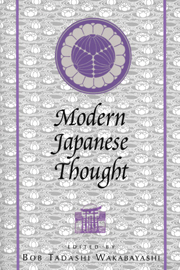3 - Meiji Conservatism
Published online by Cambridge University Press: 05 June 2012
Summary
The Meiji period bequeathed to modern Japan a powerful conservative tradition that dominated government and society in the twentieth century. Meiji conservatism took shape at the end of the nineteenth century in reaction to the sweeping reforms and Western influence that had held sway in the first two decades of Meiji. Those reforms, which brought to fruition the demands for change that had grown during the late Tokugawa, drew their inspiration from Western ideas and institutions that were the products of the Enlightenment and of the liberal philosophies that accompanied the emergence of commercial capitalism and a bourgeois class dissatisfied with traditional forms of government in Europe. The Meiji ruling group, after initially adopting many of the ideas and institutions of the Enlightenment, subsequently promoted a powerful conservative program in order to sustain its power and the social order on which it rested.
Conservatism, in the sense used here, is not simply a tendency to maintain the status quo. Rather, it is a distinctly modern phenomenon that first developed in the West in the late eighteenth and early nineteenth centuries in reaction to the dominant themes of the Enlightenment and to the implications of the French Revolution. Although conservatism had distinctive features in different European countries, owing to their divergent histories and social structures, certain common features became apparent wherever it arose in the West. It is worthwhile to examine our topic in the context of European conservatism, in part because the Japanese conservatives drew inspiration from their European counterparts and in part because comparisons will prove meaningful in understanding the nature of Meiji conservatism.
- Type
- Chapter
- Information
- Modern Japanese Thought , pp. 98 - 146Publisher: Cambridge University PressPrint publication year: 1998
- 2
- Cited by



